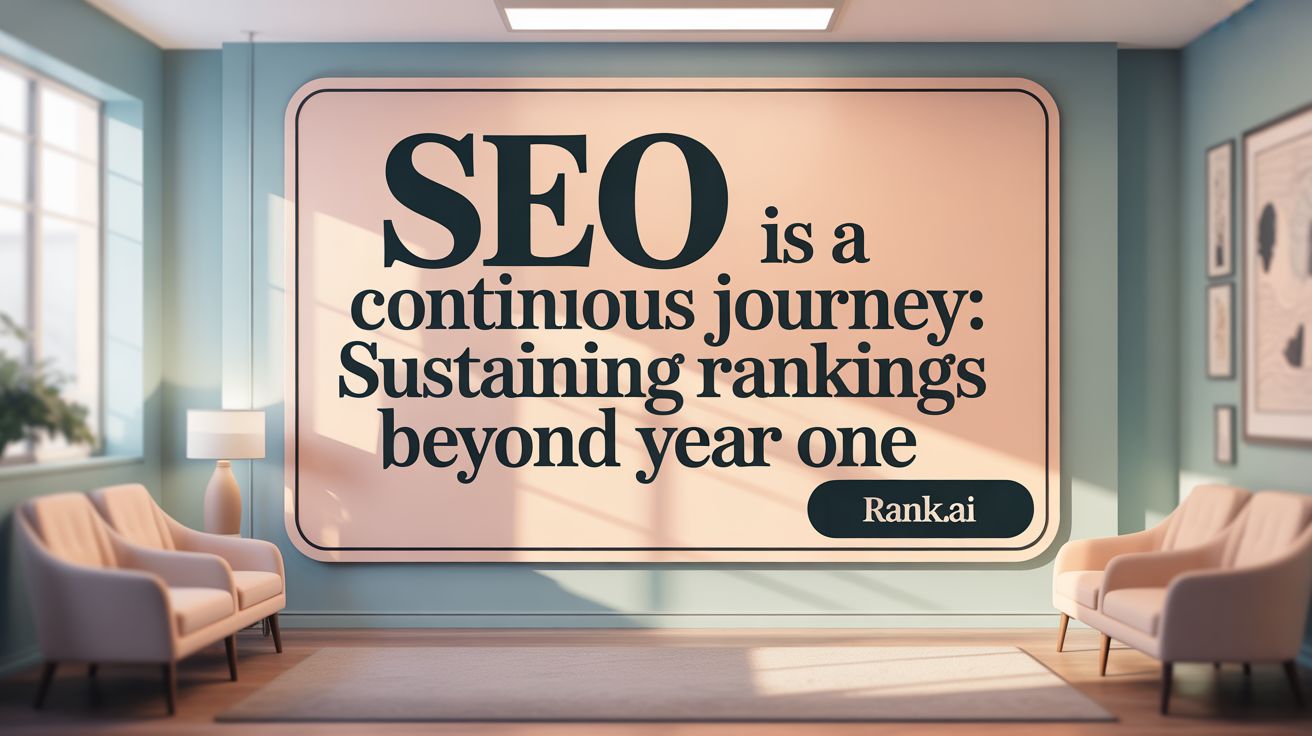Setting the Stage for SEO Success
SEO is a crucial digital marketing strategy, but one of the most common challenges businesses face is understanding the timeline to see measurable results. This article demystifies how long SEO efforts typically take to generate visible impact, explains the stages involved, unpacks the factors influencing the timeline, and offers guidance on setting realistic expectations throughout the process.
How Long Does It Take to See Results from SEO Efforts?
Search engine optimization (SEO) is a strategic process that yields gradual and sustained improvements in a website's visibility. On average, most SEO campaigns start to show noticeable results within three to six months. This period allows for critical steps such as technical audits, content updates, keyword optimization, and link building to take effect.
For newer websites, the timeline can extend up to a year before significant changes in rankings and traffic become evident. Established sites with existing authority and good backlink profiles tend to experience faster improvements, often within the first few months.
The degree of competition in your industry heavily influences how quickly SEO results manifest. Highly competitive sectors like finance, health, or law may require 12 to 24 months to observe substantial rankings. In contrast, niche or low-competition keywords can show improvements in just a few months.
Achieving long-term success in SEO involves patience and ongoing effort. Regular content creation, technical adjustments, and backlink acquisition are vital. Moreover, SEO is not a one-time task; algorithm updates, industry shifts, and evolving user behaviors necessitate continuous optimization.
Typical signs of progress include higher rankings for long-tail keywords, increased organic traffic, and better crawl stats observed around months three or four. Over six to twelve months, significant growth in rankings and backlink profiles usually takes place. After approximately a year, SEO efforts can generate scalable, self-reinforcing results, reducing dependence on paid advertising.
Understanding these timelines helps set realistic expectations. Most websites see noticeable improvements within 3 to 6 months, but it’s the persistent effort over 6 to 12 months that truly establishes a strong online presence. Consistency and patience are essential to maintaining growth and adapting strategies as digital landscapes evolve.
Typical Timeline for SEO Ranking Progress
What is the typical timeline for SEO ranking progress?
The process of improving search engine rankings usually begins to produce noticeable results within three months. During this initial phase, Google and other search engines start to recognize changes such as content updates, technical fixes, and improved user experience. Early indicators include higher click-through rates for targeted keywords and slight movement in rankings.
By around six months, many websites observe more significant improvements, with rankings stabilizing for certain keywords and an increase in organic traffic. This is often when the effects of optimized content, backlinks, and technical health start to compound, leading to more enduring results.
For new sites, the timeline is often longer, sometimes taking up to a year before rankings are meaningful and consistent. New websites require time to build domain authority, attract backlinks, and be fully indexed by search engines.
Progress depends heavily on various factors. These include how competitive the industry is, the quality of content, site structure, backlink profile, and ongoing optimization efforts. Technical health and user experience improvements—like faster loading times and easier navigation—can accelerate early success.
Overall, SEO is a gradual and ongoing journey. While some initial improvements are possible within three months, the majority of sustained and significant results generally appear between six months to a year. Continuous effort and adaptation are essential to maintain and advance rankings over time.
Key Factors Influencing the SEO Results Timeline

What factors influence the timeline for SEO success?
The duration for achieving noticeable and lasting SEO results varies widely, typically spanning from four months to over a year. Most businesses begin to see initial improvements around the 6-month mark, provided there is consistent and strategic effort.
In the early stages, months 1 to 2, efforts are concentrated on research, technical audits, and establishing a solid foundation. This involves fixing site errors, improving crawlability, and optimizing technical elements that impact indexing.
Between months 3 to 6, focus shifts to content creation, keyword targeting, and building backlinks. During this period, signs of progress such as improved rankings for long-tail keywords, increased site traffic, and better crawl stats usually emerge.
Several factors influence how rapidly SEO results materialize:
- Competition Level: Highly competitive industries like finance, health, or law often require longer periods—up to 12-24 months—to see significant results.
- Website Authority and Age: Established sites with a strong backlink profile and history tend to rank quicker than new websites.
- Content Quality and Relevance: Creating high-quality, relevant content tailored to user intent accelerates rankings.
- Backlink Profile and Link Building: Developing a robust backlink portfolio can lead to faster authority growth and improved rankings.
- Technical SEO Health: A technically optimized site with fast load times, proper indexation, and no errors can see early wins within weeks.
- Resource Availability: Adequate internal and external resources dedicated to SEO activities influence the speed of results.
- Importance of Continuous Optimization: SEO is ongoing; as algorithms evolve and competition shifts, continuous efforts in optimization, content updating, and backlink development are vital for maintaining and improving rankings.
While initial signs such as traffic increases and keyword improvements appear within the first 3 to 6 months, reaching full competitive ranking success often takes 6 to 12 months or longer. Monitoring progress regularly and adjusting strategies based on analytics help in sustaining growth and achieving long-term SEO benefits.
In summary, patience and persistent effort are crucial. Understanding the multiple influencing factors allows marketers to set realistic expectations, plan effective strategies, and allocate resources efficiently to maximize SEO success over time.
Stages of SEO Progress Over Time: From Setup to Sustainability

What are the typical stages of SEO progress over time?
SEO development is a gradual process with distinct phases that unfold over months, depending on industry competitiveness and website health. Initially, during months 0-2, focus is on conducting comprehensive site audits, technical SEO fixes, and detailed keyword research. This foundation sets the stage for more advanced efforts.
In months 2-4, technical improvements such as fixing site errors, enhancing crawlability, and structuring the website effectively are prioritized. During this period, content creation begins, focusing on on-page optimization—such as adding relevant keywords, meta descriptions, and improving user experience.
Between months 4 to 6, link-building activities intensify, leading to increased domain authority and trustworthiness. Content marketing efforts contribute to improved rankings and more organic traffic as backlinks accumulate. These months often mark the start of measurable increases in visibility.
From months 6 to 12, the website often stabilizes in ranking positions. Traffic growth accelerates, and rankings for relevant keywords tend to solidify. It’s common here to see increased organic visibility, conversions, and website authority. Achieving and maintaining high rankings in competitive industries may extend beyond this period.
Looking beyond the first year, consistent optimization and new content updates help sustain momentum. Long-term results, including ongoing traffic and authority growth, mainly depend on continuous effort and adaptation to algorithm changes.
It's important to note that new websites typically see results between 6 to 12 months, due to the time needed to build domain authority and backlinks. Established sites, with existing authority and content, often achieve noticeable results faster, often within 3 to 6 months.
In sum, SEO progress travels through stages: initial audits and technical fixes, content development and on-page tweaks, authority building through backlinks, and finally consolidation and growth of traffic and rankings. Each phase requires patience, strategic effort, and ongoing optimization to ensure long-term success.
Setting Realistic Expectations for SEO Results at Different Phases

Expectations During Initial Months (0-3)
In the first few months of an SEO campaign, efforts are primarily focused on laying a solid foundation. This includes technical audits, fixing site errors, optimizing site structure, conducting keyword research, and creating initial content. During this phase, clients and stakeholders should not expect dramatic increases in traffic or rankings. Instead, early signs of progress, such as minor ranking fluctuations for long-tail keywords, improved crawl stats, or slight increases in website visits, are typical.
It's normal for SEO results in this period to be incremental. The emphasis is on setting up the infrastructure needed for future growth. Technical fixes and content updates often start to show measurable impacts within weeks to two months but don’t usually translate into major rankings until later.
Milestones by Month 6
Around the six-month mark, significant milestones can be observed. Most websites, especially established ones, begin to see noticeable improvements in rankings for targeted keywords, increased traffic levels, and better engagement metrics. Backlink profiles might expand, and internal linking structures become more effective.
This period often reflects the first tangible results of ongoing link-building, content optimization, and technical enhancements. However, in competitive markets like finance, health, or law, meaningful gains may still take longer.
Growth and Maturity Around 12 Months
By the time a year has elapsed, SEO efforts tend to mature. Results typically settle into a stable position, with the website ranking well for core keywords and generating consistent organic traffic. Brand authority usually solidifies, reducing dependence on paid advertising.
In challenging niches, reaching this level of maturity could extend beyond a year. Continuous content creation, backlink acquisition, and technical maintenance are vital to sustain and grow these gains. A well-implemented SEO strategy at this stage should produce scalable, self-reinforcing results that contribute to long-term business success.
Importance of Data-Driven Goal Setting
Achieving realistic expectations relies heavily on analyzing data. Keyword opportunities, competition levels, and current domain authority serve as benchmarks for setting attainable goals. Regular monitoring of metrics like rankings, traffic, click-through rates, and conversions helps refine objectives and strategies.
Using tools such as Google Analytics, Search Console, and competitive analysis platforms allows marketers to forecast outcomes more accurately and adjust expectations based on real-world performance.
Adapting Goals Based on Ongoing Performance
As campaigns progress, initial forecasts should be revisited. If certain keywords or market segments outperform expectations, goals can be elevated. Conversely, if results lag behind, strategies might need to be optimized, or expectations reset.
Continuous review and flexibility are crucial. SEO is long-term and dynamic; adapting goals ensures steady progress without setting unrealistic targets that could demotivate teams or clients.
Managing Client or Stakeholder Expectations
To foster trust and patience, clear communication is essential. Emphasize that SEO is a gradual process influenced by numerous factors like industry competition, website health, and content relevance. Explaining typical timelines and milestones helps set a realistic outlook.
Highlight success stories, transparent reporting, and step-by-step progress updates to reinforce that positive results are on the horizon. Managing expectations effectively ultimately leads to sustained support and better collaboration.
Debunking Common Misconceptions About SEO Timelines
Many people hold false beliefs about how quickly SEO results can materialize. A widespread misconception is that SEO provides instant outcomes. In reality, it often takes three to six months to see noticeable changes, with full results sometimes taking up to a year or more, especially in competitive markets.
Another common error is relying heavily on a single strategy, such as keyword optimization or backlink building, expecting rapid success. Effective SEO involves a holistic approach — combining technical improvements, quality content, proper internal and external linking, and continuous optimization.
Some confuse guaranteed rankings with the reality of SEO. There are no guarantees for top positions; search engine algorithms constantly evolve, and competition remains fierce. Success depends on ongoing efforts and adapting strategies over time.
Misunderstandings also exist around content length or keyword use. While relevant, high-quality content and targeted keywords are important, they alone are not enough. Technical health, user experience, and acquiring authoritative backlinks are essential components that influence the timeline.
Lastly, many underestimate the importance of sustained and consistent work. SEO is not a one-and-done activity but a continuous process. Strategies need to be regularly refined to maintain and improve rankings, traffic, and authority.
In summary, the typical SEO timeline spans from a few months to over a year. It involves patience, persistent effort, and a comprehensive approach to truly achieve lasting results. Recognizing these facts helps create realistic expectations and enables more effective planning of SEO campaigns.
When to Evaluate the Effectiveness of Your SEO Efforts
How long should one wait before evaluating the effectiveness of SEO efforts?
Assessing SEO results requires patience, as improvements do not happen overnight. Most experts recommend waiting between three to six months before conducting a formal review of your SEO progress. During this initial period, your efforts—such as technical optimizations, content updates, and link building—start to influence your rankings and organic traffic.
For new websites or highly competitive industries like finance or health, it may take closer to six to twelve months to see significant changes. These longer timelines are due to the need to build domain authority, gain backlinks, and establish relevance in your niche.
Several factors influence how quickly SEO results appear, including the site's technical health, content relevance, keyword competitiveness, backlink profile, and overall industry landscape. The first three months mainly focus on laying the groundwork with technical improvements and content creation.
By the four- to six-month mark, you should begin observing notable signs of progress, such as increased website traffic, improved rankings for target keywords, and better crawl stats. This period is ideal for a comprehensive evaluation.
Ongoing monitoring beyond this point helps track progress, identify areas for refinement, and ensure sustained growth. Patience and consistency are critical, as SEO is a long-term strategy that builds momentum gradually. Regular reviews at six months or later enable you to adjust your strategy effectively, ensuring your efforts translate into meaningful, lasting results.
Accelerating SEO Results Without Sacrificing Quality
How can targeting low-competition long-tail keywords help accelerate SEO results?
Focusing on less competitive, long-tail keywords allows websites to rank more quickly for specific queries. These keywords typically have lower search volume but less competition, enabling faster initial visibility and traffic growth. This approach can lead to early signs of improved rankings and increased traffic within a few months.
What technical optimizations can speed up SEO progress?
Technical SEO plays a crucial role in improving search engine crawlability and site speed. Fixing site errors, optimizing page load times, ensuring proper indexation, and enhancing mobile responsiveness can lead to early gains, often within weeks to two months. These foundational improvements lay the groundwork for more significant ranking advancements over the following months.
How does content alignment with user intent influence speed of results?
Creating high-quality, relevant content that matches user intent helps search engines understand your site’s relevance quickly. Optimizing content around targeted keywords, semantically related terms, and addressing user questions can result in faster rankings improvement. For less competitive keywords, results may be visible within 1–2 months, while highly competitive terms take longer.
In what ways can promoting content for backlinks accelerate SEO efforts?
Backlinks remain a vital off-page factor affecting rankings. Proactively promoting content to earn backlinks from authoritative sources can significantly boost domain authority in a shorter timeframe. Outreach efforts, guest posting, and content sharing can generate backlinks within a few months, leading to noticeable ranking improvements over three to six months.
Why is continuous, data-driven optimization essential?
SEO is dynamic, influenced by algorithm updates, competitors, and user behavior. Regularly analyzing performance metrics such as traffic, rankings, and backlinks allows for adjustments that improve results. Continuous refinement—like updating outdated content, sharpening keywords, and improving technical elements—helps sustain momentum, especially after initial gains in the 3–6 month window.
How does understanding SEO timelines help set realistic expectations?
Results typically become noticeable between three to six months, with more substantial improvements manifesting around the six- to twelve-month mark. Strategies that combine technical fixes, content development, and link building can accelerate results without compromising quality. Patience and ongoing optimization are essential for long-term, sustainable SEO success.
Understanding the Four Pillars of SEO and Their Timelines

Technical SEO Timeline and Early Impact
Technical SEO forms the foundation of a website's search engine performance. Improvements such as fixing site errors, enhancing crawlability, and optimizing site speed often show initial benefits within weeks to two months. These technical adjustments can quickly improve how search engines index and understand your site, setting the stage for better rankings.
On-Page Content Optimization Results
Optimizing content with relevant keywords, high-quality writing, and proper structure begins to yield noticeable ranking improvements within 1 to 2 months for less competitive keywords. For highly competitive topics, improvements may take approximately 4 to 6 months or more. Consistent content updates and optimization efforts are crucial for maintaining and enhancing these results over time.
Off-Page Backlinks Growth Period
Building backlinks and increasing site authority usually takes between three and six months to influence rankings effectively. High-quality backlinks carry more weight and can extend this timeframe to 12 months or longer in competitive industries. As backlinks accumulate, they reinforce your site’s authority and credibility, leading to more sustained ranking improvements.
User Experience Improvements and Ranking Influence
Enhancing user experience—like faster load times and easier navigation—can lead to quicker engagement and conversion rates within weeks. However, their effect on search rankings generally appears over two to four months, as search engines increasingly prioritize user-friendly sites. These improvements also contribute to increased organic traffic and better overall user satisfaction.
How These Pillars Interact to Shape Overall Progress
All four pillars of SEO—technical health, content quality, backlinks, and user experience—work together over time to boost your site's search visibility. Improvements in technical SEO lay the groundwork, while quality content and backlinks build authority, and user experience encourages engagement. When aligned and continuously optimized, these elements create a compounding effect, leading to sustained growth in rankings, traffic, and leads. Typically, noticeable overall SEO progress unfolds within three to six months, with full results developing over 6 to 12 months or more, especially in competitive sectors.
The Ongoing Nature of SEO: Beyond the First Year

Importance of sustained optimization
SEO is not a one-time effort; it requires continuous attention to keep and improve rankings. Even after initial results appear around three to six months, ongoing efforts in technical fixes, content updates, and link building are essential. This persistent development helps maintain visibility amidst changing algorithms and competitor strategies.
Impact of algorithm updates
Search engine algorithms frequently change, which can influence site rankings unexpectedly. These updates often necessitate regular adjustments to your SEO approach. Staying informed about these updates and adapting your strategies accordingly ensures your website remains competitive.
Competition and evolving user behavior
In competitive markets, gaining and keeping top rankings demands constant effort. User preferences and search patterns also evolve, requiring ongoing content optimization and user experience improvements. Monitoring industry trends and adjusting your tactics helps sustain long-term growth.
Continuous content updates and backlink building
Adding fresh, relevant content and building backlinks regularly are foundational to long-term success. These activities improve authority and relevance, which are critical for ranking stability. Consistency in these efforts yields sustained gains and reduces reliance on paid traffic.
How SEO matures into a self-reinforcing process
Over time, successful SEO becomes a self-reinforcing cycle. Higher rankings attract more organic traffic, which increases opportunities for backlinks and engagement. As your site gains authority, it becomes easier to rank for more competitive keywords, creating a positive feedback loop for ongoing growth.
This ongoing cycle underscores the importance of viewing SEO as a long-term commitment, aimed at fostering continuous improvement and adapting to an ever-changing digital landscape.
Navigating Your SEO Journey with Realistic Timelines
SEO is a strategic journey that unfolds over months, not days. Understanding the typical timelines, the stages of progress, and the factors influencing results equips marketers and business owners to set pragmatic goals and maintain steady efforts. While initial improvements might appear within three to six months, realizing the full benefits often requires six to twelve months or longer, particularly in competitive environments or for new websites. Embracing SEO as a continuous, evolving process anchored in quality, technical excellence, and user experience ultimately paves the way for sustainable growth and online success.
References
- How Long Does SEO Take to Work? Timeline Explained
- How Long Does it Really Take to Get SEO Results? - Digi Solutions
- How Long Does it Take to See SEO Results? | Uproer
- How Long Does SEO Take to Work? A Realistic Timeline
- Understanding the Timeline for SEO Results: How Long Does It Take?
- How long does it take to see results from SEO? - Fiverr Answers
- How Long Does SEO Take To Show First Results? | Promodo.com
- How Long Does SEO Take? - Medium
- How Long Does SEO Take to Work? [+ Tips for Quick Results]



